A TF2 Stream of Consciousness Journey
Today we are going to take a journey through various entertainment mediums, beginning and ending at our familiar game of TF2, through a sort of free association. At each step of the journey we will find some (hopefully interesting) fact about the work in question which in turn connects us to another work, and from there we will connect to another work via some other bit of trivia and so on, until we finally arrive back where we started. As Charles Fort said “one measures a circle starting anywhere,” so Team Fortress 2 is as good of starting location as any other.
Team Fortress 2 has had a great deal of interactions with other games through the use of promos, but direct crossovers have been rarer. The cross over which was perhaps the most high profile, while paradoxically being the most forgettable, was the appearance of the Spy, Pyro and Heavy in Sonic and All-Stars Racing Transformed. This page shows Valve’s announcement of the crossover. They were the exclusive characters to the PC version, and were likely chosen because of the game’s use of the Steam platform.
It’s easy to look at Sonic and All-Stars Racing Transformed as simply a Sonic: The Hedgehog version of Mario Kart with random console exclusives thrown in. Even the title suggests this way of looking at things, since what are these “All-Stars” anyway? The “All-Stars” are in fact “Sega All-Stars,” meaning important characters from Sega’s other in-house series. These would include Ulala, from Space Channel 5, and Ryo Hazuki, from Shenmue.
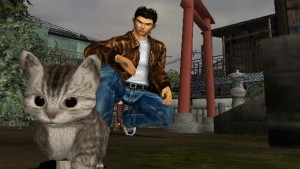
As it so happens there is another game which features lesser known Sega characters, including Ryo and Ulala: Project X Zone 2. This is of course a direct sequel to Project X Zone, but it is an indirect sequel to Namco X Capcom, which was similar in many ways but restricted itself to characters from the titular two companies. Like any good crossover franchise, the series has a set of original characters who act as the “main characters,” which avoids giving preference to any one company. These would be Reiji Arisu and Xiaomu:
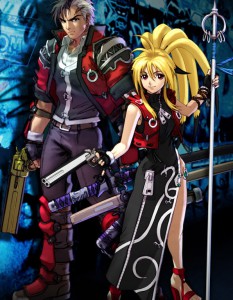
The pair also appears in Super Robot Wars: Endless Frontier as playable characters. Much of that game is related to the events of Super Robot Wars: Original Generations 2, and in particular to the plot arc of Kyosuke Nanbu and Excellen Browning. When we compare the two games we notice another similarity:
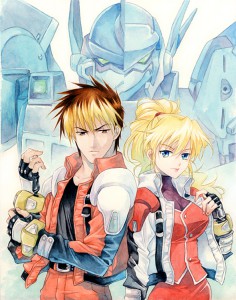
There’s no nice way to say this: Reiji and Xiaomu are ripoffs of Kyosuke and Excellen. In addition to the physical similarities (such as Reiji/Kyosuke’s two-toned hair or Xiaomu/Excellen’s tied back blond hair), the two couples have almost identical personalities with both Reiji and Kyosuke being stoic and serious, both Xiaomu and Excellen being flirtatious goofs, and the deep romance present between each couple not apparent at first glance. In fact, this is completely intentional. The director of Namco X Capcom is the same as the director of Super Robot Wars Impact, which introduced Kyosuke and Excellen. Endless Frontier even lampshades this by having the ATX uniform of Kyosuke and Excellen’s team as an equipable item, which of course can only be used by Reiji and Xiaomu.
The Super Robot Wars series primarily is a crossover series for various giant robot anime, but it has produced a surprising number of its own characters and robots (enough to carry several games which contain nothing but original characters). Like any successful franchise in Japan it has had a huge amount of merchandising produced for it. One notable line of merchandise is Bandai’s Super Robot Chogokin series of figures which hosts 8 original robots from the series out of 38 total figures. Additionally, most of the anime which appear in the series have also made an appearance in the Super Robot Wars series. However, the series in the last most familiar to western audience may be the Super Sentai series, or as it is known in its adaptations, Power Rangers.
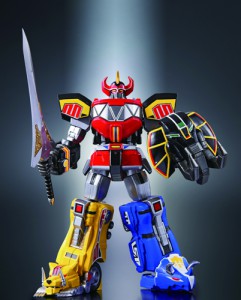
The Super Sentai franchise is an example of “Tokusatsu” type series (or “toku” for short). According to Wikipedia’s fake definition this genre technically consists of shows which use a lot of special effects, but chances are when someone speaks of “toku” he means a show in which people put on dumb costumes to look like monsters, robots or super heroes and proceed to beat each other up. Super Sentai differs from many other similar shows such as Kamen Rider in its constant usage of giant robots, but the first big Toku series in Japan that utilized giant robots was actually Spider-Man. Yes, that, Spider-Man.
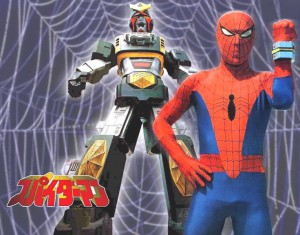
It shouldn’t be surprising to find a Japanese adaptation of Spider-Man from the 70’s, since Spider-Man has always been one of Marvel Comic’s flagship characters. Western readers may be more familiar with one of the animated versions of Spider-Man. Which one you are thinking of may vary, since there have been at least eight different Spider-Man cartoons. Many have suffered from low budgets or other limitations. The nineties version had to deal with severe censorship restrictions, such as never being able to kill anyone or even refer to death. This made things a bit tricky when they decided to include the Punisher, whose whole M.O. is brutally murdering villains to make up for the fact that his own family was brutally murdered.
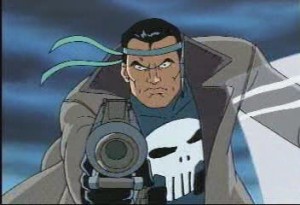
It might seem crazy to throw a character best known for wanton violence into a cartoon which could hardly show violence in the first place, but its far from the craziest crossover that the Punisher has been involved with. Most people would agree that that honor belongs to the time he chaperoned Archie’s School Dance.
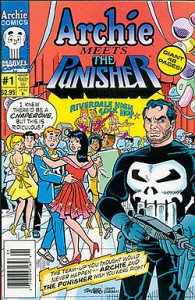
Of course, Archie has crossed over with nearly everything in a desperate attempt to be relevant. While it may be hard to believe that Archie and the Punisher crossed paths, it would perhaps be harder to believe if Archie didn’t crossoever with the Ninja Turtles, and sure enough that happened too.
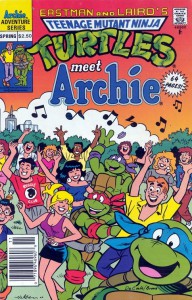
Now the Turtles themselves were huge in the 80’s. Even before they got a popular cartoon show, and all the merchandising that goes along with it, even before that the original comic book by Eastman and Laird was quite influential. There are nearly countless variants of “super powered animal teams” that appeared immediately afterwards, such as the Adolescent Radioactive Black Belt Hamsters, the Immature Radioactive Samurai Slugs, or the Pre-Teen Dirty-Gene Kung-Fu Kangaroos. As you can say, most of them weren’t trying to hide things at all (and many were satirical), but they are largely forgotten these days. However, there was one comic book about an animal hero from the same time which lasted a bit longer and is better remembered today. It even had several crossovers with the Turtles themselves. I am speaking of the story of the noble rabbit samurai, Usagi Yojimbo.
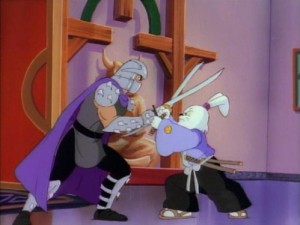
If you are interested in Usagi Yojimbo today, one way to get into it may be by starting up a game of the official tabletop rpg published by Sanguine productions, who are perhaps more famously known for producing Ironclaw, aka “that rpg which would be really good if it wasn’t about furries.”
Ironclaw itself has a somewhat embarrassing history relating to the cover of its first edition:
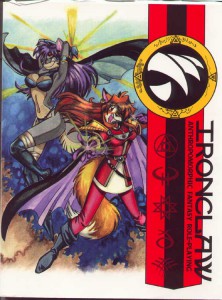
If you are not an anime fan, you might not see what is controversial about this, beyond perhaps the fact that it features scantily clad furries. Well, let’s compare this to the poster for the movie version of The Slayers:
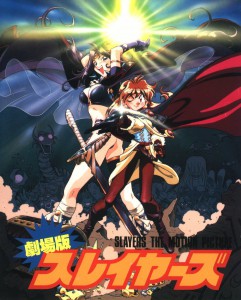
Not only is the character composition the same, but the two characters in the images are wearing the exact same outfits. This is not a coincidence. Sanguine productions was still a small company with practically no resources when they made the first edition of Ironclaw. Rather than using entirely new art, they partially used (with permission) existing artwork from furry artists which fit the setting. They particularly liked the piece that they used for the cover, but they were unaware that it was actually explicit fanart for The Slayers. The red fox on the front, who is the equivalent of the redhead Lina Inverse (and main character of The Slayers) on the poster, became one of the premade characters of the game and was extremely popular, despite being a transparent ripoff of Lina. She even made into the second edition, albeit with a redesigned wardrobe to get around copyright fights.
Speaking of Lina Inverse, there happens to be another western work which contains a thinly veiled ripoff of her. This would be the DOTA series, with the character Lina. Lina the Slayer. As if that wasn’t enough to tip you off to the reference, in DOTA 2 Lina’s attacks include the Dragon Slave, the Light Strike Array and the Laguna Blade, which are all spells used by Lina Inverse (introduced in The Slayers, Slayers: The Motion Picture, and Slayers: Next respectively). I still find it astounding that the character remains as is, considering all of the characters in that game who were changed to distance themselves from their original Warcraft inspirations.
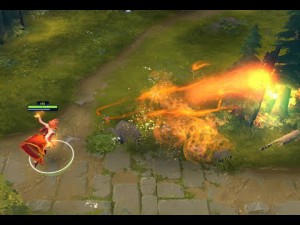
Somehow we have arrived back at a Valve product, despite our excursions into obscure comics, rpgs and Japanese media. From here it’s a short hop back to TF2. We could try to move through the rest of Valve’s series, but since this column is nearing 2000 words I’ll take the easy way out and note that TF2 has three promotional items relating to DOTA 2: Storm Spirit’s Hat, Clockwerk’s Helm and Sniper’s Sniping Glass. We could also note that the voice actor of DOTA 2’s Sniper did voice work for TF2, while the voice actor of TF2’s Sniper did voice work for DOTA 2 (though sadly the two games do not share the shame voice actor for both snipers.)
So now the circle is complete and our journey has come to end. Hopefully you have learned something which isn’t completely useless along the way.
I find it funny how everything nicely connects, from TF2 and Power Rangers to even Archie and OMG The Slayers. (I should check that out again; it’s part of my childhood.) Nice bedtime story.